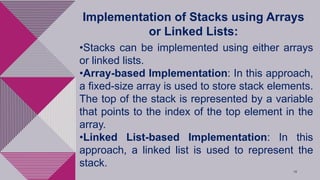Data Structure and Algorithm Lesson 2.pptx
- 1. ADVANCED DATA STRUCTURES Trees Heaps Hash tables Graphs Arrays Linked Lists Stacks Queues
- 2. 2 Introduction to Arrays An array is a collection of items of the same variable type that are stored at contiguous memory locations.
- 3. Basic Terminologies of Array Array Index: In an array, elements are identified by their indexes. Array index starts from 0. Array element: Elements are items stored in an array and can be accessed by their index. Array Length: The length of an array is determined by the number of elements it can contain.
- 5. 5 Linked Lists A linked list is a linear data structure consisting of a sequence of elements called nodes, where each node contains both the data and a reference (or pointer) to the next node in the sequence.
- 6. 6 Types of Linked Lists There are several types of linked lists, but the two most common ones are: 1.Singly Linked List: In this type of linked list, each node contains data and a pointer to the next node in the sequence. The last node points to null, indicating the end of the list. 2.Doubly Linked List: Each node in a doubly linked list contains data, a pointer to the next node, and a pointer to the previous node. This allows for traversal in both directions.
- 7. OPERATIONS ON LINKED LISTS: 7 1.Insertion: Adding a new node to the list. 2.Deletion: Removing a node from the list. 3.Traversal: Iterating through the list to access or manipulate its elements. 4.Search: Finding a specific element within the list. 5.Concatenation: Combining two linked lists into one.
- 8. Insertion: Example: Suppose we have a singly linked list with nodes containing integers. To insert a new node with the value 10 at the end of the list: Original Linked List: 1 -> 2 -> 3 -> NULL After Insertion: 1 -> 2 -> 3 -> 10 -> NULL
- 9. Deletion: •Example: Continuing from the previous example, if we want to remove the node containing the value 2 from the list: Original Linked List: 1 -> 2 -> 3 -> 10 -> NULL After Deletion: 1 -> 3 -> 10 -> NULL
- 10. Traversal: Example: Suppose we have the following singly linked list with characters representing a string. Traversing the list would mean iterating through each node and printing its value: Linked List: 'H' -> 'e' -> 'l' -> 'l' -> 'o' -> NULL Traversal Output: Hello
- 11. Search: Example: Consider the same linked list from the traversal example. If we want to search for the character 'l' in the list: Linked List: 'H' -> 'e' -> 'l' -> 'l' -> 'o' -> NULL Search for 'l': Found at index 2 and 3
- 12. Concatenation: Example: Suppose we have two singly linked lists, list1 and list2, with the following elements: list1: 1 -> 2 -> 3 -> NULL list2: 4 -> 5 -> 6 -> NULL Concatenating list2 to the end of list1 would result in: Concatenated List: 1 -> 2 -> 3 -> 4 -> 5 -> 6 -> NULL
- 13. 13 Applications of Linked Lists •Dynamic Memory Allocation: Linked lists are commonly used in dynamic memory allocation systems, such as malloc() and free() in C. •Implementation of Stacks and Queues: Linked lists serve as the underlying data structure for implementing stacks (using singly linked lists) and queues (using either singly or doubly linked lists). •Polynomial Manipulation: Linked lists can be used to represent and manipulate polynomials in mathematical computations. •Sparse Matrix Representation: Linked lists are suitable for representing sparse matrices efficiently.
- 14. #include <stdio.h> #include <stdlib.h> struct Node { int data; struct Node* next; }; struct Node* createNode(int data) { struct Node* newNode = malloc(sizeof(struct Node)); if (!newNode) { printf("Memory allocation failed!n"); exit(1); } newNode->data = data; newNode->next = NULL; return newNode; }
- 15. int main() { struct Node* head = createNode(10); head->next = createNode(20); head->next->next = createNode(30); printf("Linked List: "); for (struct Node* current = head; current != NULL; current = current->next) printf("%d -> ", current->data); printf("NULLn"); for (struct Node* current = head; current != NULL;) { struct Node* temp = current; current = current->next; free(temp); } return 0; }
- 16. 16 Stacks: •Definition and properties of stacks (Last In First Out - LIFO). •Implementation of stacks using arrays or linked lists. •Operations on stacks (push, pop, peek). •Applications of stacks in expression evaluation, function calls, and backtracking algorithms.
- 17. 17 Definition and Properties of Stacks (Last In First Out - LIFO): •A stack is a linear data structure that follows the Last In First Out (LIFO) principle, meaning that the last element added to the stack is the first one to be removed. •Stacks can be visualized as a collection of elements arranged in a specific order where elements are added and removed from the top (the end where insertion and deletion occur).
- 18. 18 Implementation of Stacks using Arrays or Linked Lists: •Stacks can be implemented using either arrays or linked lists. •Array-based Implementation: In this approach, a fixed-size array is used to store stack elements. The top of the stack is represented by a variable that points to the index of the top element in the array. •Linked List-based Implementation: In this approach, a linked list is used to represent the stack.
- 19. 19 Operations on Stacks (push, pop, peek): •Push: Adds an element to the top of the stack. •Pop: Removes the element from the top of the stack. •Peek: Returns the element at the top of the stack without removing it.
- 20. 20 Applications of Stacks •Expression Evaluation •Function Calls •Backtracking Algorithms
Editor's Notes
- #3: The dream of every programmer is to become not just a good, but also a great programmer. We all want to achieve our goals and to achieve our goals, we must have a great plan with us. In this context, we have decided to provide a complete guide for Arrays interview preparation, which will help you to tackle the problems that are mostly asked in the interview, such as What is an Array, What is Array in C language, How do you initialize an Array in C, How to sort an Array, etc. We have also covered the topics such as Top Theoretical interview questions and Top interview coding questions in this complete guide for Array interview preparation. It’s one of the most popular and simple data structures and is often used to implement other data structures. Each item in an array is indexed starting with 0.
- #7: Unlike arrays, linked lists do not have a fixed size, and their elements are not stored in contiguous memory locations. Instead, each element (node) points to the next one, forming a chain-like structure.
- #15: In this example: We define a structure Node to represent a node in a linked list. It contains an integer data field and a pointer to the next node. The createNode() function dynamically allocates memory for a new node using malloc(). If memory allocation fails, it prints an error message and exits the program. In the main() function, we initialize an empty linked list and insert nodes dynamically using the createNode() function. After printing the elements of the linked list, we free the memory allocated for each node using the free() function to prevent memory leaks. This example demonstrates how linked lists are used in conjunction with dynamic memory allocation functions like malloc() and free() to manage memory dynamically in C programs. ``` 1. **`#include <stdio.h>` and `#include <stdlib.h>`**: - These are preprocessor directives in C. - `#include <stdio.h>` includes the standard input/output library, which provides functions like `printf()` and `scanf()`. - `#include <stdlib.h>` includes the standard library, which provides functions like memory allocation (`malloc()`, `calloc()`, `realloc()`) and memory deallocation (`free()`). 2. **`struct Node { ... };`**: - This defines a structure named `Node`. - It contains two members: `int data` (to store integer data) and `struct Node* next` (a pointer to the next node in the linked list). 3. **`struct Node* createNode(int data) { ... }`**: - This is a function named `createNode()` that returns a pointer to a newly allocated `Node` structure. - It takes an integer parameter `data`, which represents the data to be stored in the node. - Inside the function: - It allocates memory for a new `Node` structure using `malloc(sizeof(struct Node))`. If memory allocation fails (`malloc()` returns `NULL`), it prints an error message and exits the program using `exit(1)`. - It assigns the input `data` to the `data` member of the newly created node. - It initializes the `next` pointer of the node to `NULL`, indicating that it's the last node in the list. - Finally, it returns a pointer to the newly created node. Overall, this code defines a basic structure for a singly linked list node (`Node`) and a function to dynamically create new nodes (`createNode()`). The inclusion of standard libraries (`<stdio.h>` and `<stdlib.h>`) provides necessary functionality for input/output operations and memory allocation/deallocation.
- #16: int main() { // Create the head of the linked list and initialize it with a node containing data 10 struct Node* head = createNode(10); // Create the second node with data 20 and attach it to the head node head->next = createNode(20); // Create the third node with data 30 and attach it to the second node head->next->next = createNode(30); // Print the elements of the linked list printf("Linked List: "); for (struct Node* current = head; current != NULL; current = current->next) printf("%d -> ", current->data); printf("NULL\n"); // Free memory allocated for the linked list nodes for (struct Node* current = head; current != NULL;) { // Store the current node in a temporary variable struct Node* temp = current; // Move to the next node current = current->next; // Free the memory allocated for the current node free(temp
- #21: 4. Applications of Stacks: Expression Evaluation: Stacks are commonly used in evaluating arithmetic expressions, such as infix, postfix, and prefix expressions. Operators and operands are pushed onto the stack, and operations are performed based on their precedence and associativity. Function Calls: Stacks are used in function call mechanisms, such as maintaining the call stack in recursive function calls. When a function is called, its local variables and the return address are pushed onto the stack, and they are popped off when the function returns. Backtracking Algorithms: Stacks are utilized in backtracking algorithms, such as depth-first search (DFS), to store the state of exploration. During backtracking, the algorithm pops elements from the stack to backtrack to previous states and explore other paths.



















